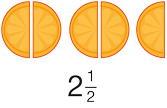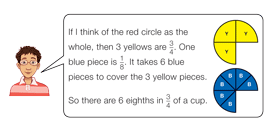Students use fraction circle pieces to represent fractions and to define a unit whole when given a fraction of the whole. They write fractions in words and numbers.
Content in this Lesson
- Using words and symbols to name fractions [E1].
- Identifying a fractional part of a whole [E1].
- Recognizing that equal fractional parts of a unit whole are the same size [E2].
- Identifying the unit whole when given a fractional part of a whole [E3].
- Finding equivalent fractions using circle pieces [E4].
- Finding equivalent fractions using multiplication and division strategies [E4].
- Comparing fractions using circle pieces [E6].
- Naming fractions greater than one as mixed numbers and improper fractions [E1].
Daily Practice and Problems C–F
Assessment in this Lesson
| Assessment | Expectation Assessed | Math Practices Expectation Assessed |
|---|---|---|
|
Candy Fractions with Feedback Box |
|
|














 .
. 
 where a and b are whole numbers and b is not zero. For example,
where a and b are whole numbers and b is not zero. For example,  , 0.5, and 2 are all fractions since 0.5 can be written as
, 0.5, and 2 are all fractions since 0.5 can be written as  and 2 can be written as
and 2 can be written as  . Numbers like
. Numbers like  and
and  are also fractions.
are also fractions. ,
,  , and
, and  are improper fractions.
are improper fractions.

